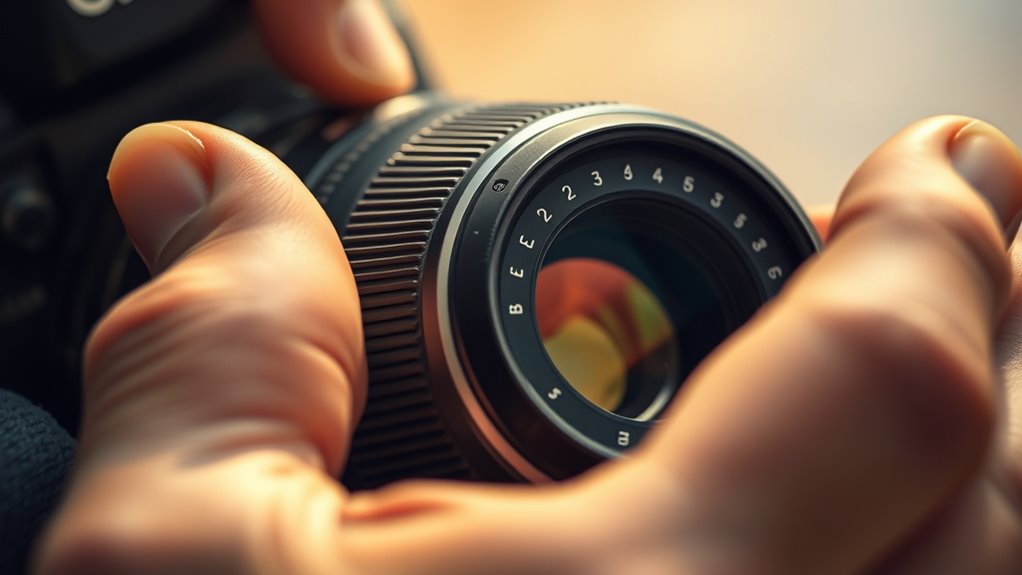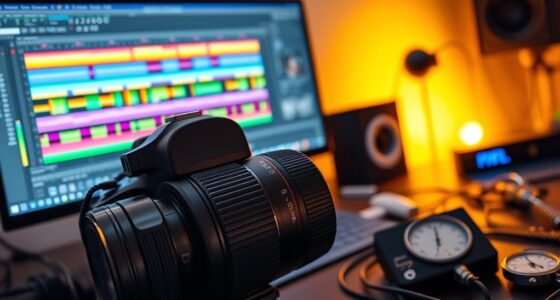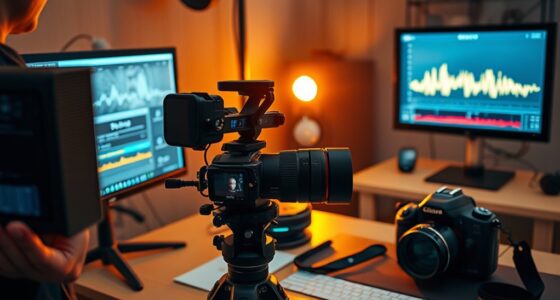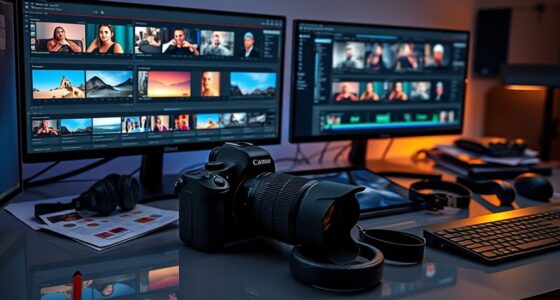Mastering manual focus requires more than just turning a ring. Use tools like focus peaking and focus aids such as magnification to see exactly what’s sharp. Practice smooth focus shifts, like rack focus, for cinematic shots, and consider techniques like back-button focus or focus lock to improve accuracy. Shooting in low light? Adjust your aperture and verify calibration for better results. If you keep exploring, you’ll discover ways to elevate your focus skills even further.
Key Takeaways
- Use focus peaking and magnification tools for precise manual focusing, especially in challenging lighting conditions.
- Regularly calibrate lenses to prevent focus inaccuracies and ensure smooth focus transitions.
- Practice controlled focus pulls and rack focusing techniques to create cinematic depth and guide viewer attention.
- Utilize back-button focus and focus lock methods to maintain sharpness during re-framing or subject movement.
- Patience and consistent practice are essential to mastering manual focus and achieving professional results.
Understanding Focus Peaking and Its Hidden Benefits
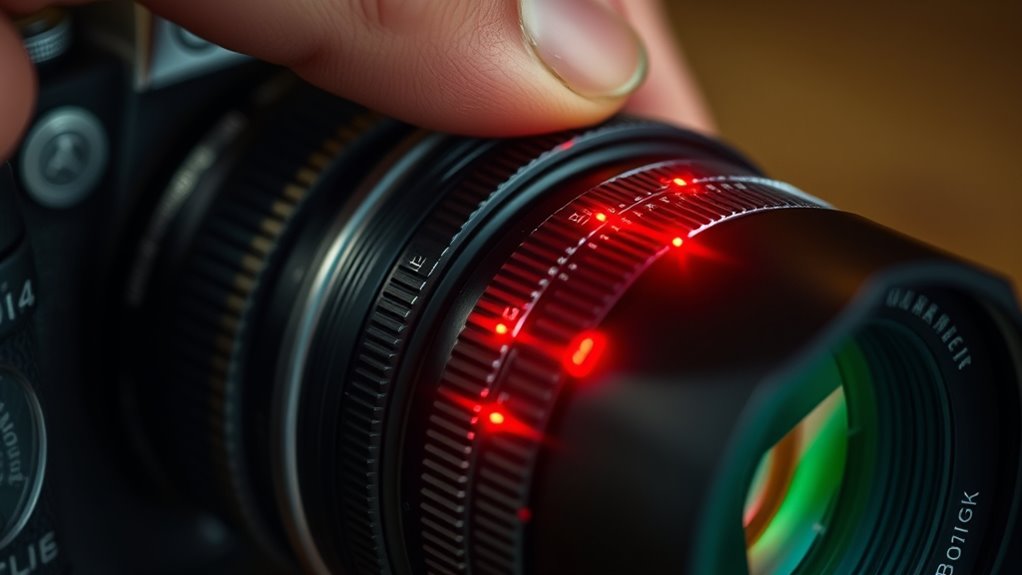
While focus peaking is often seen as just a helpful feature for manual focusing, it actually offers several hidden benefits that can improve your overall photography. One key focus peaking benefits is that it provides real-time visual feedback, making it easier to achieve sharp focus quickly and accurately. This reduces the guesswork and minimizes missed shots. Using focus peaking also trains your eye to recognize critical focus areas, sharpening your manual focusing skills over time. Incorporate these manual focusing tips by paying attention to the color and intensity of the peaking highlights, which indicate where your lens is in focus. Additionally, understanding the fundamentals of sound design can inspire creative approaches to visual storytelling that complement your technical skills, ultimately elevating your photography to the next level.
Using Focus Aids and Assistive Tools for Precision
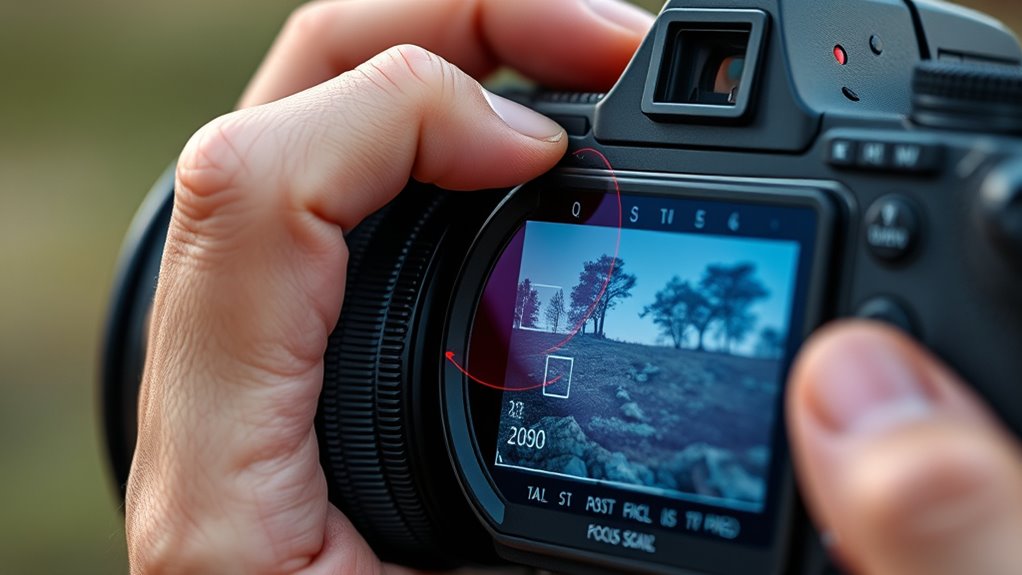
Using focus aids and assistive tools can considerably enhance your manual focusing accuracy. These tools help overcome autofocus limitations, especially when precision is critical. For example, focus magnification allows you to zoom in on your subject, making fine adjustments easier. Focus peaking highlights edges in focus, guiding you to ideal sharpness. Regular lens calibration ensures your lens and camera work together perfectly, preventing subtle focusing errors. Consider using electronic viewfinders or LCD screens with focus assist features, which provide real-time feedback. Combining these aids streamlines the focusing process, reducing guesswork and increasing accuracy. Remember, relying solely on autofocus can be problematic in tricky lighting or high-contrast scenes, so these tools become invaluable for achieving sharp, professional results. Additionally, studies on Glycolic Acid Benefits for Skin suggest that using assistive tools can lead to more consistent and reliable focus, much like consistent skincare routines improve skin texture and appearance.
Techniques for Shooting in Low Light and Difficult Conditions
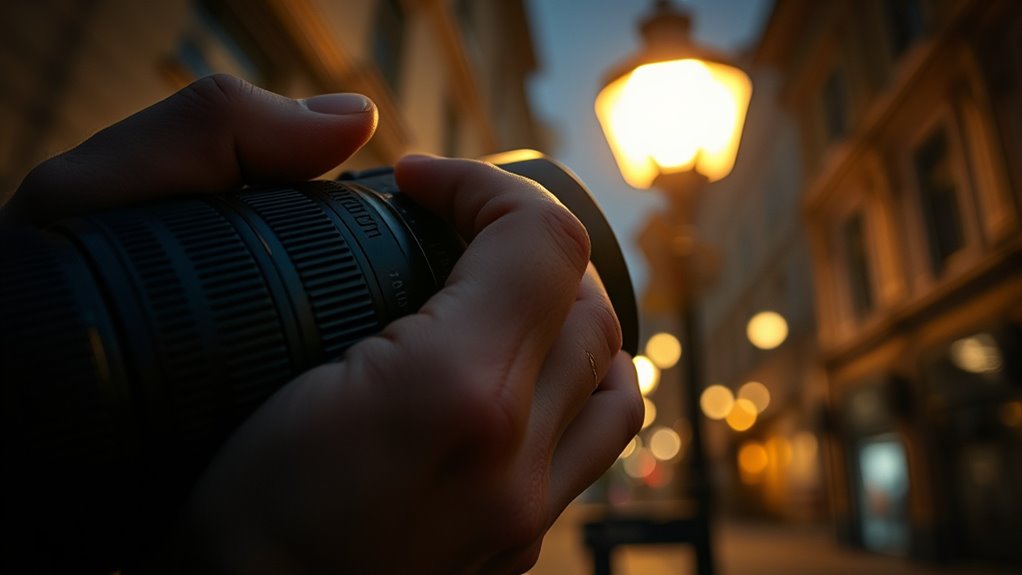
When shooting in low light or tough conditions, focus peaking can be a game-changer, highlighting the sharpest areas of your image. You should also consider adjusting your manual aperture to control depth of field and improve focus accuracy. These techniques help you maintain clarity even when visual cues are limited. Additionally, understanding the importance of contrast ratio can help you better interpret your scene’s dynamic range and optimize your camera settings accordingly.
Using Focus Peaking
Focus peaking is an invaluable tool for achieving sharp focus in low light and challenging conditions. It highlights the in-focus areas with colored outlines, making manual focus easier when autofocus comparison isn’t reliable. To optimize results, verify your lens calibration is accurate, as misaligned focus can undermine peaking effectiveness. When comparing autofocus performance, use focus peaking to verify precise focus, especially in tricky lighting. This technique helps you fine-tune focus points quickly and confidently. Keep in mind, peaking works best with high-contrast subjects, so choose your focus areas wisely. Here’s a quick comparison:
| Autofocus | Focus Peaking |
|---|---|
| Fast but sometimes inaccurate | Precise in low contrast scenes |
| May hunt in low light | Requires good contrast for visibility |
| Needs calibration | Relies on proper lens calibration |
Mastering focus peaking enhances manual focusing, especially in tough conditions. Additionally, understanding camera settings can further improve your focusing accuracy in difficult scenarios.
Employing Manual Aperture
Have you considered how adjusting your aperture manually can significantly improve your low-light and difficult shooting conditions? Aperture control allows you to manage the amount of light entering your lens, which is essential when lighting is limited. By opening your aperture wider, you maximize light intake, helping you capture clearer images in dim environments. Conversely, stopping down the aperture increases depth management, keeping more of your scene in focus—ideal for landscapes or detailed shots. Mastering manual aperture lets you balance exposure and depth precisely, giving you better control over your shot‘s brightness and clarity. This technique requires practice but offers greater flexibility in challenging conditions, ensuring your images are sharp, well-exposed, and visually compelling even when light is scarce. Understanding how to use toilet flushing mechanisms effectively can also help conserve resources and prevent issues during water shortages or plumbing problems.
Mastering Focus Transition and Rack Focus for Cinematic Effects
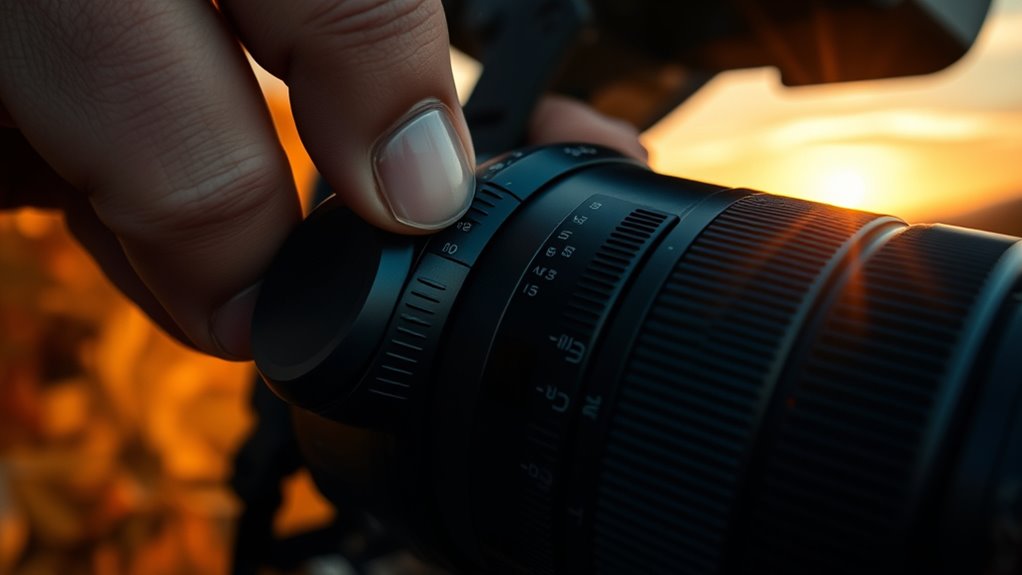
Mastering focus shift and rack focus can add cinematic depth to your shots. With smooth focus pulls and creative techniques, you can guide your audience’s attention effortlessly. Let’s explore how to achieve these effects seamlessly and effectively. Incorporating proper focus techniques ensures your transitions look natural and professional, elevating your overall cinematography skills.
Smooth Focus Pulls
Smooth focus pulls are essential for creating seamless shifts between subjects or emphasizing specific elements within a scene. They allow you to control depth precisely, guiding the viewer’s attention effortlessly. To achieve fluid transitions, practice maintaining consistent movement and speed, avoiding abrupt changes that can distract viewers. Focus stacking isn’t typically used during live focus pulls, but understanding how it enhances depth control in stills can inform your technique. Use manual focus rings carefully, adjusting gradually to shift focus smoothly from foreground to background or between subjects. Keep your hand steady or use a focus puller rig to improve precision. Mastering these techniques ensures your focus transitions feel natural, cinematic, and engaging, elevating your storytelling and visual impact.
Creative Focus Transitions
Ever wondered how filmmakers create seamless, attention-grabbing shifts in focus that draw your eye exactly where they want it? Creative focus transitions, like rack focus, can do just that. To master these, ensure your lens calibration is spot-on, preventing focus hunting during transitions. Use manual focus or troubleshoot autofocus issues beforehand to keep control sharp. Smooth focus pulls involve planning your focus points and timing carefully. Here’s a quick overview:
| Technique | Tip |
|---|---|
| Focus Pull Planning | Practice beforehand for precise control |
| Lens Calibration | Regularly calibrate to avoid focus drift |
| Autofocus Troubleshooting | Resolve focus hunting issues before filming |
| Transition Execution | Use smooth, deliberate movements for effect |
These steps help you craft cinematic focus shifts that captivate your audience. Additionally, understanding the importance of manual focus techniques can significantly improve your control and results.
Rack Focus Techniques
Rack focus is a powerful technique that filmmakers use to shift the viewer’s attention seamlessly between subjects within a scene. To execute this effectively, you need to understand your lens calibration, ensuring smooth focus shifts. Manual focus allows for precise control, especially when autofocus limitations prevent quick or accurate adjustments. When mastering rack focus, practice moving focus from one subject to another smoothly, avoiding abrupt changes that can distract viewers. Be mindful that inconsistent lens calibration can cause jitter or focus slipping. Using manual focus also helps you control the depth of field, creating cinematic effects that guide your audience’s eye. Additionally, understanding the importance of focus transition techniques can help you achieve more professional results. With patience and proper technique, you can elevate your storytelling by emphasizing key moments through seamless focus transitions.
Fine-Tuning Focus With Back-Button and Focus Lock Methods
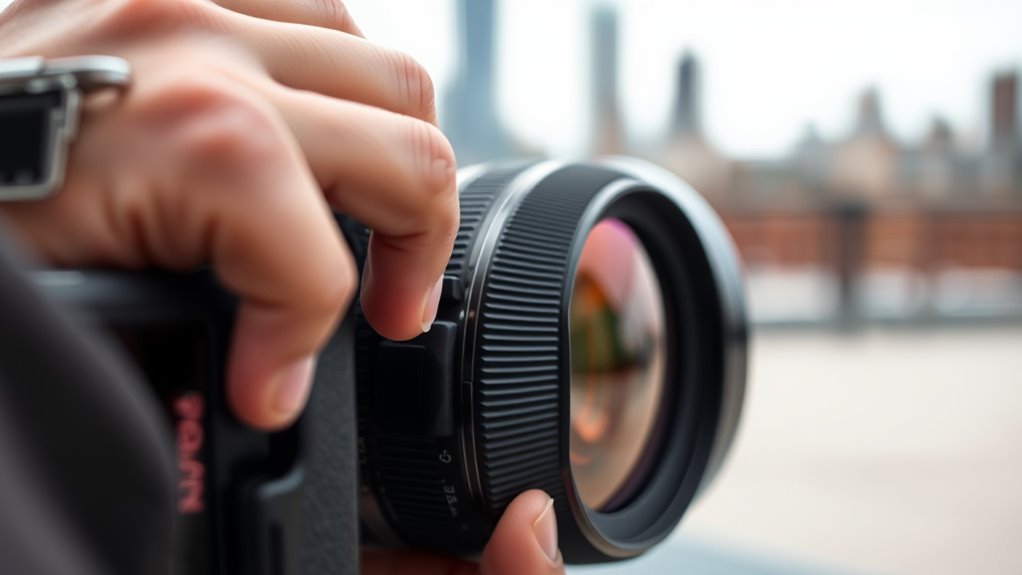
To achieve precise focus, many photographers rely on back-button focus and focus lock techniques, which give you greater control over your camera’s autofocus. With back button focus, you separate autofocus from the shutter button, allowing you to lock focus by pressing a dedicated button. Focus lock lets you temporarily hold focus on a subject, even if it moves. These methods help prevent focus shifts during composition or when recomposing shots. Use focus lock to ensure your subject remains sharp while adjusting your framing. Here’s a quick comparison:
| Technique | How It Works |
|---|---|
| Back Button Focus | Press to focus, release to lock; separate from shutter |
| Focus Lock | Lock focus with a button, then recompose if needed |
Practicing Focus Accuracy With Real-World Exercises
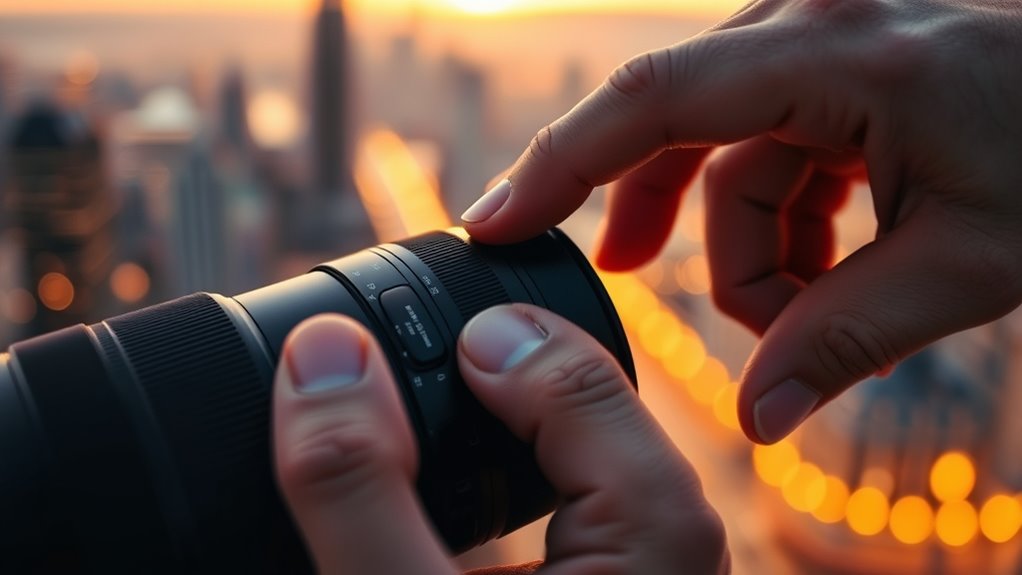
Practicing focus accuracy with real-world exercises helps you develop a steady hand and keen eye for sharp images. By engaging in activities like photographing moving objects or close-up details, you enhance your depth perception, which is essential for manual focusing. These exercises reveal autofocus limitations, such as difficulty locking focus in low light or with low-contrast subjects. To improve, intentionally switch to manual focus and challenge yourself to achieve precise sharpness. Use a tripod or stabilize your camera to reduce shake, and practice focusing on different distances to sharpen your skills. Over time, you’ll better judge focus points and compensate for autofocus shortcomings, building confidence in your manual focusing abilities under various conditions. Understanding traditional focus techniques can also provide a solid foundation for mastering precise focus in diverse scenarios.
Frequently Asked Questions
How Does Focus Peaking Vary Across Different Camera Brands?
Focus peaking varies across camera brands because each offers unique brand specific autofocus features and customization options. You’ll notice differences in color, intensity, and sensitivity settings that let you tailor focus peaking to your needs. Some brands like Sony and Canon provide extensive focus peaking customization, while others may have simpler implementations. Experiment with your camera’s settings to optimize focus peaking, making manual focus faster and more precise.
What Are Common Mistakes When Using Focus Aids in Manual Focus?
Did you know that 65% of photographers struggle with focus aid misalignment? When using focus aids, one common mistake is relying too much on them, which can cause you to overlook actual focus accuracy. Overreliance can lead to soft images, especially if the aid isn’t perfectly aligned. Always double-check focus manually and use focus aids as a guide, not a crutch, to make certain sharp results.
How to Adapt Manual Focus Techniques for Wildlife or Fast-Moving Subjects?
When photographing wildlife or fast-moving subjects, you should anticipate autofocus limitations and prepare with wildlife camera gear. Use focus peaking or focus magnification to fine-tune manual focus quickly. Keep your camera steady and pre-focus on an area where the subject is likely to pass. Practice panning smoothly and anticipate movement to stay sharp. These techniques help you adapt manual focus efficiently, even in rapid action scenarios.
Can Focus Transition Techniques Be Applied Effectively in Handheld Video Shooting?
Yes, focus shift techniques work well in handheld video shooting if you prioritize handheld stability. Keep your movements smooth and controlled to maintain focus accuracy during transitions. Practice your focus pulls gradually to avoid jerky footage, and use your body to stabilize the camera. Combining focus transition with steady handling ensures sharp images and professional-looking results, even when you’re on the move.
What Are Advanced Settings to Optimize Focus Lock Accuracy?
To optimize focus lock accuracy, you should fine-tune your camera’s autofocus settings, such as adjusting the focus sensitivity and tracking speed. Use focus peaking to enhance focus accuracy visually, and enable focus lock with a dedicated button for consistent lock precision. Additionally, consider customizing your autofocus area mode to suit your subject’s movement, ensuring you maintain sharp focus and reliable lock precision during dynamic shots.
Conclusion
Mastering manual focus means embracing patience, precision, and practice. It’s about understanding your tools, experimenting with techniques, and pushing through challenging conditions. With focus peaking, aids, and real-world exercises, you’ll sharpen your skills and elevate your photography and videography. Remember, clarity comes from consistency, confidence from practice, and creativity from control. Keep experimenting, keep refining, and watch your images come into perfect focus—sharp, stunning, and uniquely yours.

